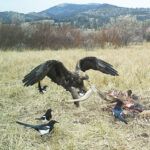By Michael Howell

Bird rehabilitators here in the Bitterroot have been dealing with the problem of lead poisoning of raptors for a long time. This past month a sick eagle was discovered near Hamilton and taken to Wild Skies Raptor Center in Missoula. According to Brooke Tanner at the center the bird’s blood-lead levels were off the chart. The eagle could not be saved. Nor could one brought in from the St. Regis area. According to Robert Domenech, Executive Director of Raptor View Research Institute in Missoula, lead has been recognized for a long time as a toxin with serious, even fatal, effects on humans and other animals. Its use has been discontinued in pipes, in gasoline, in paint and elsewhere for health reasons.
Lead has also long been documented as a serious hazard to eagles and other predatory and scavenging avian species. As a result, the use of lead shotgun pellets for waterfowl hunting on federal and state lands was banned in 1991 due to lead poisoning in Bald Eagles, Golden Eagles and numerous waterfowl species.
The Raptor View Research Institute has a study site in the Bitterroot Valley on the MPG Ranch near Florence where they capture Golden Eagles to further their research on the migratory birds. Domenech and Heiko Langner have authored a scientific article concerning the blood-lead levels of fall migrant Golden Eagles in West-Central Montana.
They note that a study done by Harmata and Restani between 1983 and 1985 showed elevated blood-lead levels in spring migrating eagles sampled in west-central Montana showed elevated blood-lead levels in 85% of 86 Golden Eagles and 97% of 37 Bald Eagles. The authors suggested that lead shot from waterfowl hunting and fragmented lead-core rifle bullets in ground squirrels were the source of the lead.
More recently, lead poisoning from spent ammunition has been identified as the leading cause of death in California Condors, prompting a ban on lead ammunition in the California Condor Recovery Zone.
Another recent study, according to Domenech, on common ravens in the Jackson Hole area of Wyoming, has shown a direct correlation between elevated blood-lead levels and the onset of the rifle hunting season.
“Blood-lead levels spiked following the opening of the hunting season and remained elevated until two weeks after the hunting season closed,” said Domenech.
Domenech and Langner sampled blood from 42 Golden Eagles captured on migration during the fall of 2006 and 2007, looking for heavy metal contaminants, with an emphasis on lead. In all they found 58% of the 42 fall migrant Golden Eagles had elevated blood-lead levels.
“We are uncertain whether our preliminary numbers represent the northern migratory population of Golden Eagles as a whole, but a serious threat to the welfare of the species on a landscape level appears plausible,” they note in their study. “We believe an intensive education outreach campaign and a switch away from lead-containing hunting ammunition to alternative, less toxic materials are appropriate ways to protect these and other scavenging species, as well as human consumers of gun-killed animals.”
Domenech said that the science was convincing. Studies show that lead bullets fragment into many pieces inside the animal that is shot, contaminating the meat. He said this should be of concern to humans who eat the meat as well as the birds who eat the gut piles.
Domenech said that the Raptor View Institute was not interested in passing any legislation prohibiting the use of lead ammunition, nor were they promoting any sort of ban.
“We don’t want that at all,” said Domenech. “We just want to share the information we’ve gathered so people can make informed decisions. We feel that if we can just put the information out there people will switch to copper or copper alloy ammunition for hunting for the benefit of their family and the wildlife.”
It is in this spirit that Domenech invites the public to attend the presentation of Eagles & Ammo featuring the Montana premier of the film, “The Non-Lead Hunter.” The film features life-long hunter Anthony Prieto on the hunt, demonstrating the effectiveness of non-lead ammunition. With striking visuals, the film vividly illustrates the threat that fragments from lead ammunition pose to opportunistic, scavenging animals like eagles, as well as humans who consume wild game. It is a story of how small changes can have big effects in preserving wildlife for future generations. Prieto, a lifelong hunter with an acute awareness of the toll lead ammunition takes on scavenger species like eagles and the California condor, will be in attendance. The Eagles and Ammo event is being held at the University Center building on the UM campus on April 29 at 6 p.m. and will also feature a lively panel discussion, ballistics information, ammunition discounts and refreshments.
“The voluntary use of non-lead ammunition allows hunters a unique opportunity to maintain support for hunting programs by demonstrating a commitment to safe, quality hunting practices that will benefit the long-term conservation of wildlife,” said Domenech.
